
MAY CONTAIN NUTS

Search Shorpy
SHORPY ART

Framed or unframed, desk size to sofa size, printed by us in Arizona and Alabama since 2007. Explore now.
Join and Share
Ad-Free Shorpy
Shorpy is funded by you. Patreon contributors get an ad-free experience.
Learn more.

Recent comments
- Yellow sky at morning
- Side Winder
- Air Quality?
- Sojourner Truth riot
- None were so blind(ed)
- The less famous sister
- Good ol' days?
- Rise and Fall
- Goo Goo Ga Joob
- Ticket Retention
- Not the only one
- Vagaries of War
- Killed by Amtrak
- Back to the Future
- Wanted --
- If you can't stand the light
- Centralized Traffic Control, I believe
- What's really happening
- Heckuva remote control!
- Sometimes — Things Go Bump!
- I SEE THE LIGHT
- Union Switch and Signal Company
- Get That Light Out Of My Eyes
- Eggs. Eggs. Eggs. The Egg Man is Here!
- Foreboding caption
- Famous Hollywood faces
- Not just S&P
- re: Those things in the jar
- Up In Smoke
- Medical Smoking
Member Photos
The Shorpy
Print Emporium
Print Emporium
Search Shorpy
Search results -- 30 results per page
- Missionary Ridge: 1902
- ... Ridge from Cameron Hill." 8x10 inch glass negative by William Henry Jackson. View full size.
Knowlt Hoheimer Obligatory Edgar ... Posted by Dave - 06/20/2017 - 10:28am -
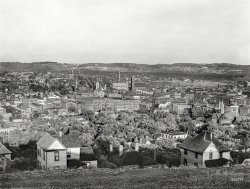
- Wild Palms: 1897
- ... the Ormond hammock." 8x10 inch dry plate glass negative by William Henry Jackson, Detroit Photographic Company. View full size.
... Posted by Dave - 08/13/2019 - 11:40am -
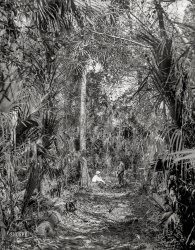
- Old Florida: 1898
- ... rail line circa 1898, captured on an 8x10 glass plate by William Henry Jackson. View full size.
Self-Serve Room Service According to ... Posted by Dave - 12/08/2016 - 4:01pm -
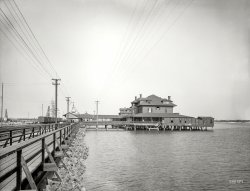
- Family Tree: 1904
- ... gent seen earlier perched on the railing, possibly William Henry Jackson with his grandchildren. 8x10 glass negative, Detroit Publishing ... Posted by Dave - 02/23/2019 - 12:18pm -
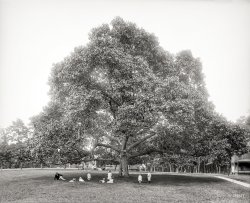
- St. George Street: 1894
- ... George Street, St. Augustine." 8x10 inch glass negative by William Henry Jackson. View full size.
Re: The Cage Grand mystery solved! ... Posted by Dave - 03/09/2019 - 5:35pm -
![St. George Street: 1894 Florida circa 1894. "St. George Street, St. Augustine." 8x10 inch glass negative by William Henry Jackson. View full size.
Re: The CageGrand mystery solved! Once again Dave's one liners start my day off with a laugh!
The CageThere is a caged shelf jutting out right above the little boy in the front of the picture. It is not unlike the guards installed around urban window air conditioners on a street level window. They are used to safeguard the air conditioner and protect the room behind it from a break in. Was it used for winter storage of perishables? Anybody know what they were used for?
[One clue might be the bird inside. - Dave]
St. St. St.I'm amused by all the abbreviations in the caption... Two Saints and a Street!
I'm also loving this batch of FL pix. I'm a native Floridian (from the Panhandle) and I love seeing how the state used to look. But I have a hard time imagining how anyone survived in those days, pre-A/C.
Barber plankInstead of a pole outside the barber shop on the left. I also noticed some lightning rods on top of some of the taller buildings. With Florida being the number one state in lightning strikes, must have been an easy thing to sell.
I wishI could use Google street view on this picture so I could continue down the road and look at all the stores.
It is probably good that I can't, as there are so many excellent pictures here that I wish I could enter and explore. I would never get anything done!
Strange clothing shapesTwo people, one child-sized, are barely visible in the enlargement, standing in a shop doorway way down the block on the right next to the buggies. It looks as if the taller figure is a male wearing pants, a tunic over long sleeves, and a skullcap, and the shorter is wearing pants and a tunic, a bell-shaped jacket and a similar cap. I've looked at so many old Chinese-subject photos (Arnold Genthe, Felix Beato, John Thompson) that these barely visible costumes immediately look Chinese to me. Not impossible, since there were Chinese immigrants living all over the United States by 1894. But I don't know much about old Florida and its regional costumes. Could these two be Seminoles instead of Chinese? Or the neighborhood butcher in his apron, and a kid in an unlikely raincoat with a shoulder cape?
[I see Indians, Chinamen and a midget Eskimo. Click to enlarge. - Dave]
Department of Thinking Too MuchAha! Was my face red! Thanks Dave, for providing a more legible close detail. That's not a Chinaman, that's a shop boy in a dirty apron, holding an Infernal Device. As for the supposed second figure, there's no one there at all. I'd like to be able to claim that I read the Chinese figures into the image because of my annoyingly foggy laptop screen and an overindulgence in dried frog pills, but I managed to imagine the figures while stone sober. And it's Felice Beato and John Thomson, as long as I'm correcting myself. Regarding the clutter in my mind's eye, here's an Arnold Genthe photo from 1908, not all that different from what I thought I was seeing in the distance.
My wife wants to go shopping thereThere's a Singer sewing machine office, a shooting gallery, a music shop, Mackenzie's Florida Curios, and has the telegraph pole worn away from having horses tethered to it? Also, Joseph F. Canova's printers, of whom we learn more here and of the family here -- printing ink was in the blood, it would seem.
Long wire into roofIt appears that the long wire on the right just enters the house roof right through the shingles. Could this be a line marked on the picture and not an electrical or telegraph wire?
[The wire, which passes in front of the roof, ends at the pole, wrapped around it. Thanks to willc for pointing this out. - Dave]
(The Gallery, DPC, Florida)](https://www.shorpy.com/files/images/4a03633a.thumbnail.jpg)
- On the Tomoka: 1894
- ... Landing on the Tomoka." 8x10 inch glass negative by William Henry Jackson of Detroit Photographic. View full size.
Most people ... Posted by Dave - 04/15/2019 - 5:42pm -
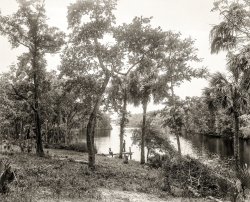
- Cast of Characters: 1897
- ... Indian River." 8x10 inch dry plate glass negative by William Henry Jackson. View full size.
Poses Late 19th century Florida, ... Posted by Dave - 01/24/2018 - 5:14am -
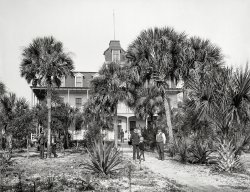
- A Vast Resort: 1895
- ... Old Point Comfort." 8x10 inch dry plate glass negative by William Henry Jackson. View full size.
"Shotgun" What appears to ... Posted by Dave - 07/05/2016 - 10:01pm -
![A Vast Resort: 1895 Hampton Roads, Virginia, circa 1895. "Hygeia Hotel, Old Point Comfort." 8x10 inch dry plate glass negative by William Henry Jackson. View full size.
"Shotgun"What appears to be a shotgun in the closer of the two launches is probably a line-throwing gun. They were used in rescue situations or to pass a line to another vessel.
Didn't burn downBut seven years after this photo:
"Rarely has anyone changed the landscape in Hampton Roads as dramatically as Secretary of the Army Elihu Root when he signed a Sept. 1, 1902 order authorizing the razing of the Hygeia Hotel."
-- Newport News Daily Press.
Naphtha LaunchesAppears to be a pair of them at the dock:
https://en.wikipedia.org/wiki/Naphtha_launch
I think we saw some others down in Florida
Pirate Ship?I look forward to an explanation of what appears to be a shotgun on the front seat-sea creatures?
Naphtha LaunchesThis pair of beautiful launches are propelled by naphtha boilers. They are not "steam launches" - the working fluid is a hydrocarbon rather than water.
The rationale of using naphtha rather than water as the working fluid is that a passenger-carrying steamboat must, by law, have a licensed engineer.
Note the beautiful flowing lines of their hulls. These were among the most lovely pleasure boats ever built.
At least some of this still existsBelieve it or not, at least one thing visible in the photo still exists, though from the closest street view you would not see it; this picture was taken from a now no longer existing jetty, and would be some thirty feet out in water. The Street View car, therefore, was some 6o feet off from the right angle and location to recapture the view.
I believe the street on the left is Ingalls Road, and the intersection just barely discernible on the left would be with Fenwick Road; none of the buildings VISIBLE are still there, but there are building hidden by the Hygeia Hotel that are. However, barely discernible in the distance on the right is the Old Point Comfort Lighthouse, along with a water tower [Gotta correct myself: the object on the far right that appears to be a watertower... isn't. It's an observation tower, now replaced with a more substantial tower, that rests on one corner of the fortress walls. I looked again and realized my error for calling it a water tower, since it's the exact same location as the more recent WWII era tower. And the outer gun line appears to have been built for WWII, not WWI.]; the Lighthouse is still there, along with other building which MAY be in the right side of the hotel, but the resolution there is too fuzzy for me to ascertain for sure (there are residences that date back that far on the stretch that should be visible, but some of the buildings visible on the extreme left may have been razed to make way for the outer gun line of Fortress Monroe, which is external to the historical Fort with it's moat and was build during WW1).
The site of the hotel itself is now Continental Park, with a small pavilion; immediately to the left (and it would have been in the picture if it had existed) is the location of the current Chamberlain hotel. On the other hand, the beaches have now moved significantly to the right and somewhat around the curve of the island; there are concrete breakwaters in this are of the island today.
Interestingly, if you use Google Earth to zoom in, you can still see some echoes of the Hygeia in the natural patterning of the grass growth in the park, as it grows slightly differently where the ground was disturbed for the buildings foundations, some 115 years after the hotels removal.
(The Gallery, Boats & Bridges, DPC, W.H. Jackson)](https://www.shorpy.com/files/images/SHORPY-4a09411a.thumbnail.jpg)
- Fountain of Frogs: 1897
- ... amphibians. 8x10 inch dry plate glass negative by William Henry Jackson. View full size.
Still there! Now part of the Flagler ... Posted by Dave - 06/05/2018 - 2:18pm -
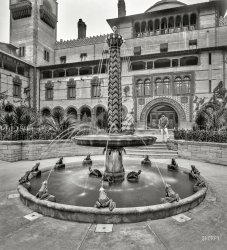
- Forsooth, Duluth: 1902
- ... Duluth, Minnesota." 8x10 inch dry plate glass negative by William Henry Jackson, Detroit Photographic Company. View full size.
... Posted by Dave - 10/25/2018 - 1:31pm -
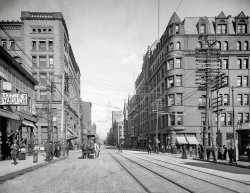
- Arch Oak: 1894
- ... moss, Ormond, Florida." 8x10 inch glass negative by William Henry Jackson. View full size.
Not Unique That area of Florida ... Posted by Dave - 11/07/2017 - 11:38am -
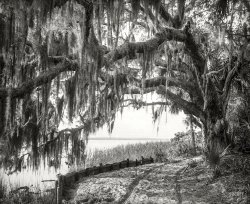
- Coconut Alley: 1894
- ... Royal Poinciana, Lake Worth." 8x10 inch glass negative by William Henry Jackson, Detroit Photographic Co. View full size.
Must have been ... Posted by Dave - 05/23/2015 - 9:44am -
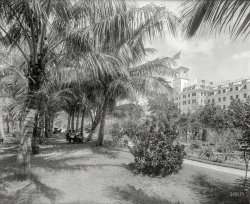
- Le Marché Français: 1890s
- ... Home to the German Grocery. 5x7 inch glass negative by William Henry Jackson. View full size.
Chapeau for Dave I know that most ... Posted by Dave - 03/13/2019 - 10:54pm -
![Le Marché Français: 1890s New Orleans circa 1890s. "The old French Market." Home to the German Grocery. 5x7 inch glass negative by William Henry Jackson. View full size.
Chapeau for DaveI know that most Americans hate those "silly diacretics diacritics", but, as we could expect, Dave distinguishes himself from those illiterate people.
NB διακριτικός (diakritikós) = distinguishing
[Thank you. And it's diacritics, not "diacretics." - Dave]
Thnx for the correction!
(The Gallery, DPC, New Orleans, Stores & Markets, W.H. Jackson)](https://www.shorpy.com/files/images/SHORPY-4a26984a.thumbnail.jpg)
- Our Eden: 1897
- ... 1897. "A garden near Daytona." 8x10 inch glass negative by William Henry Jackson. View full size.
Except for the clothes... ...it could ... Posted by Dave - 09/16/2017 - 3:11am -
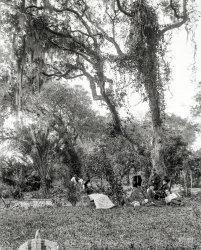
- Going Native: 1890
- ... Dawson (1877-1907). 8x10 inch dry plate glass negative by William Henry Jackson. View full size.
Things Have Changed -- Property Values ... Posted by Dave - 04/15/2019 - 11:50am -
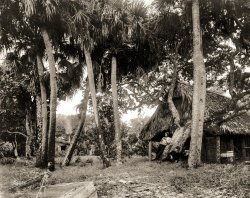
- Stairway to Heaven: 1897
- ... near Amecameca de Juárez." 8x10 inch glass negative by William Henry Jackson. View full size.
Still there, with a fresh coat of paint ... Posted by Dave - 07/29/2018 - 9:04pm -
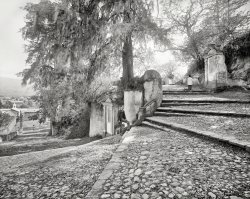
- Toxaway Lodge: 1902
- ... 1902. "The Lodge on Mount Toxaway." Glass negative by William Henry Jackson, Detroit Publishing Co. View full size.
Rooms with a View ... Posted by Dave - 08/13/2012 - 9:13pm -
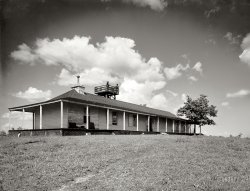
- Flagler Memorial: 1897
- ... Church, St. Augustine." 8x10 inch glass negative by William Henry Jackson. View full size.
Color enhancement The view is blocked ... Posted by Dave - 01/30/2019 - 3:47pm -
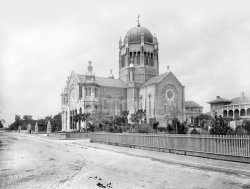
- Royal Victoria: 1900
- ... Hotel, Nassau, West Indies." 8x10 inch glass negative by William Henry Jackson, Detroit Photographic Company. View full size.
You Know ... Posted by Dave - 08/22/2017 - 11:54am -
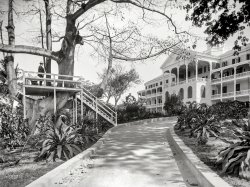
- Plaza de la Constitucion: 1897
- ... St. Augustine." 8x10 inch dry plate glass negative by William Henry Jackson, Detroit Photographic Company. View full size.
(The ... Posted by Dave - 03/30/2018 - 8:06pm -
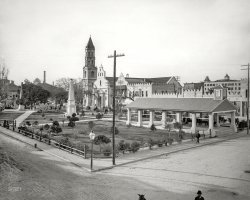
- Palm Beach: 1897
- ... at Palm Beach." 8x10 inch dry plate glass negative by William Henry Jackson, Detroit Photographic Company. View full size.
Just sit ... Posted by Dave - 06/07/2018 - 2:06pm -
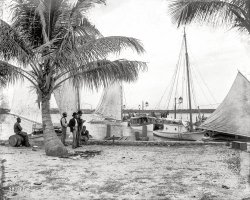
- Rockledge Greenway: 1897
- ... 1897. "Road near Rockledge." 8x10 inch glass negative by William Henry Jackson. Note the giant plate carrier held by his assistant. View full ... Posted by Dave - 03/30/2014 - 1:15pm -
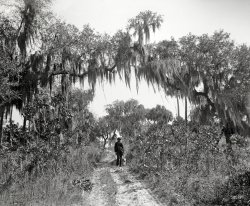
- Brinkman: 1906
- ... Maryland, circa 1906. "North from Brinkwood." With Mr. William Henry Jackson himself at the camera in this Blue Ridge mountain resort. 8x10 ... Posted by Dave - 04/03/2018 - 8:19am -
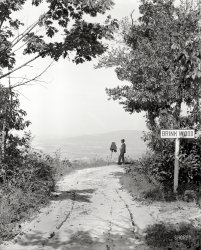
- Lake Louise: 1897
- ... Before they moved it to Alberta. 8x10 glass negative by William Henry Jackson. View full size.
(The Gallery, DPC, Florida, Landscapes, ... Posted by Dave - 08/10/2017 - 11:26am -
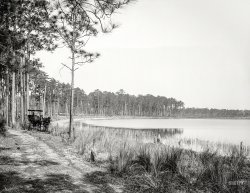
- Cotton on the Levee: 1890
- ... on the levee at New Orleans." 5x7 inch glass negative by William Henry Jackson. View full size.
(The Gallery, Boats & Bridges, DPC, New ... Posted by Dave - 03/17/2019 - 10:08am -
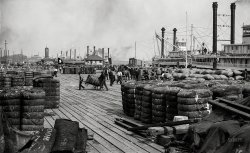
- Working Girls: 1902
- ... workings of National Cash Register. 8x10 glass negative by William Henry Jackson, Detroit Publishing. View full size.
Fire Protection ... Posted by Dave - 07/19/2012 - 12:55pm -
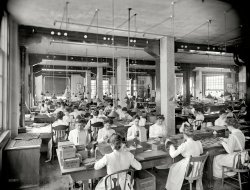
- St. George Street: 1894
- ... second look today at this bustling thoroughfare. Photo by William Henry Jackson. View full size.
(The Gallery, DPC, Florida, W.H. ... Posted by Dave - 03/09/2019 - 5:39pm -
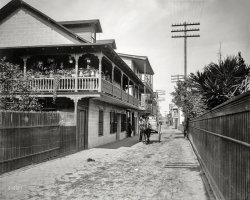
- Ebbitt House: 1900
- ... Old Ebbitt Grill a block away. 8x10 inch glass negative by William Henry Jackson. View full size.
(The Gallery, D.C., DPC, W.H. Jackson) ... Posted by Dave - 02/28/2019 - 5:44am -
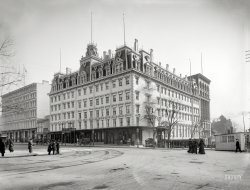
- Catch of the Day: 1894
- ... Now where's that frying pan? 8x10 inch glass negative by William Henry Jackson. View full size.
EGAD There are no railings! AND NO ... Posted by Dave - 05/06/2015 - 11:17am -
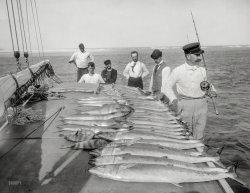
- Echo Cliffs
- ... in 1914 from a glass negative taken many years earlier by William Henry Jackson, whose Western views, developed in his railcar-darkroom, formed ... Posted by Dave - 04/04/2014 - 1:26pm -
![Echo Cliffs "Echo Cliffs, Grand River Canyon, Colorado." Photochrom print published in 1914 from a glass negative taken many years earlier by William Henry Jackson, whose Western views, developed in his railcar-darkroom, formed the basis of Detroit Photographic's holdings in the company's early years. View full size.
Great photo!I would love to see more photochromes on shorpy, autochromes too.
IntriguingI know there were color photographs years before Kodachrome, but I never knew they were available at the turn of the century. Or was this print hand-colored? It looks fantastic!
[The original photograph was black-and-white; colors were added during the printing process. -tterrace]
Glenwood CanyonThis is Glenwood Canyon, western Colorado (about 15 miles from my home). Grand River is now called the Colorado River. The railroad tracks are still there and heavily used by Union Pacific freight trains (mostly coal) as well as Amtrak passenger trains. Interstate 70 follows the canyon on the opposite side of the river. This is one of the most picturesque stretches of interstate highway anywhere in the U.S., and truly a marvel of engineering.
How it workedA tablet of lithographic limestone called a "litho stone" was coated with a light-sensitive surface composed of a thin layer of purified bitumen dissolved in benzene. A worker then pressed a reversed halftone negative against the coating and exposed it to daylight for 10 to 30 minutes in summer, or up to several hours in winter. The image on the negative caused varying amounts of light to fall on different areas of the coating, causing the bitumen to harden in proportion to the amount of light. The worker then used a solvent such as turpentine to remove the unhardened bitumen, and retouched the tonal scale of the chosen color to strengthen or soften tones as required. This resulted in an image being imprinted on the stone in bitumen. Each tint was applied using a separate stone that bore the appropriate retouched image. The finished print was produced using at least six, but more commonly 10 to 15, tint stones, requiring the same number of ink colors.
So: the original photographic negative was used to "expose" specially prepared lithographic stones, which were then etched and engraved by hand to modify them as required for each different ink color. Then the stones were used in succession to print the 6, 10, or 15 ink colors that appear in the final product.
Just two wordsThere are just two words for this Echo Cliffs colorized photo -- Incredible, Incredible.
(The Gallery, DPC, Landscapes, Photochrom, Railroads)](https://www.shorpy.com/files/images/SHORPY_4a32577u.thumbnail.jpg)























